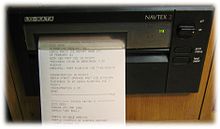SITOR
As SITOR (Simplex Teletype Over Radio) is a radio telex procedures will Seefunk designated service. The technology is known in amateur radio as Amateur Teleprinting Over Radio, or AMTOR for short .
SITOR is used in two modes. ARQ Automatic Request and FEC Forward Error Correcting . With ARQ the recipient confirms the correct reception of the sent characters, with FEC the characters are sent redundantly. While ARQ is rarely used these days, FEC is still used, e.g. B. with NAVTEX on 518 kHz. This is a worldwide safety and weather information system for maritime shipping. SITOR transmissions are sent in three blocks. A transmission is therefore 3 characters long. One character is 7 bits wide. The transmission speed is 100 baud . In the ARQ procedure, the sender waits 240 milliseconds for a response from the receiver. The shift, i.e. the difference between the lower and higher tone, is 170 Hertz with a center frequency of 1700 Hertz. From a technical point of view, SITOR is related to digital selective calling , a selective calling procedure in VHF, border and shortwave radio operations. Baud rates and low frequencies are the same.
In the past, the coastal radio stations operated extensive SITOR ARQ networks on medium, border and short wave. The United States Coast Guard also operated a worldwide network for the transmission of AMVER messages. These services were switched off in 2008 and 2012 respectively. The German coastal radio station Norddeich Radio stopped its SITOR broadcasting in 1997 . As in amateur radio, ARQ has been replaced by PACTOR in marine radio .
